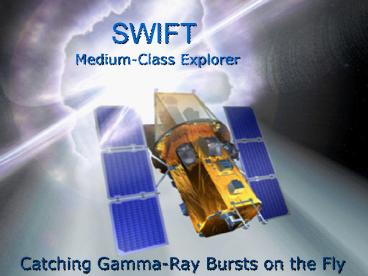SWIFT - PowerPoint PPT Presentation
1 / 14
Title:
SWIFT
Description:
5'' X-ray imaging from ~60s after burst. UVOT. 0.3'' UV & optical imaging from ~60s after burst ... X-ray spectra for redshift determination. XRT: Grazing ... – PowerPoint PPT presentation
Number of Views:72
Avg rating:3.0/5.0
Title: SWIFT
1
SWIFT
Medium-Class Explorer
- Catching Gamma-Ray Bursts on the Fly
2
Overview
- GRB physics
- Current efforts in GRB research
- The SWIFT concept
- Instrument capabilities
- Summary - why SWIFT will deliver
Björn Flatt Sigrid de Jong Gijs Roelofs 27
August 2003
3
GRB Physics
- What are the GRB progenitors?
- Long bursts supernovae?
- Short bursts ?
- What are the blast wave dynamics?
4
GRB Physics
- What different GRB classes exist?
- Long/short bursts, other classes?
- Different physics?
- Can we use GRBs to probe the early universe?
- Young massive star origin?
- Look back further than ever before?
- Star formation rate at the very beginning?
5
Current GRB Observations
- Only 1-2 events/month
- 40 manual afterglow measurements total
- X-ray follow-up 24h
- Optical follow-up 1h
Large selection effects
Were missing the blast wave!
6
What You Need
- Sensitive ?-ray detector for deep survey
- Large sky coverage many events
- Quick, multi-waveband measurement of afterglow
for blast wave reconstruction - UV to probe GRB environment
- Direct broadcast of GRB location to ground
7
The SWIFT Concept
- BAT
- GRB coordinates with 1-4 precision in 10s
- Satellite
- Slew to target autonomously in 20-70s
- XRT
- 5 X-ray imaging from 60s after burst
- UVOT
- 0.3 UV optical imaging from 60s after burst
8
The Burst Alert Telescope (BAT)
- 15-150keV range
- 1.5sr field-of-view
- GRB position within 10s
- 5 times more sensitive than BATSE
- 150 events/yr 8-fold increase of current number
in 2yr
9
BAT Coded Aperture Mask
- ?-rays fall on lead tile pattern
- Produce shadow on the semiconductor detector
array - The shadow pattern is ray-traced back to
determine direction of incidence
10
The X-Ray Telescope (XRT)
- 0.2-10keV waveband
- 5 GRB position accuracy within 60s
- Lightcurves covering 7 orders of magnitude, with
10ms time resolution - X-ray spectra for redshift determination
11
XRT Grazing Incidence Technique
- X-rays focused onto CCD using co-centric grazing
incidence mirrors - Spectroscopy using grazing incidence grating
12
The UVOptical Telescope (UVOT)
- 170-650nm photometry in 6 colour bands up to
mV24 in 1000s exposure - Spectroscopy of bright afterglows (mVlt17) gives
redshifts and extinction
13
UVOT XMM-OM Design
- Using existing know-how and parts minimises cost
and risk
14
Summary
- SWIFT provides the deep, complete survey needed
to further our understanding of GRBs - All instruments based on low-risk, proven
technology - Re-using know-how and parts ensures MidEx budget
conformity - (Launch scheduled January 2004!)























![get⚡[PDF]❤ Ultimate Taylor Swift Paint by Sticker Book: 13 Fearless Mosaic Art Designs & PowerPoint PPT Presentation](https://s3.amazonaws.com/images.powershow.com/10085018.th0.jpg?_=20240724050)
![[PDF] Who Is Taylor Swift? (Who Was?) Kindle PowerPoint PPT Presentation](https://s3.amazonaws.com/images.powershow.com/10090774.th0.jpg?_=20240802082)






